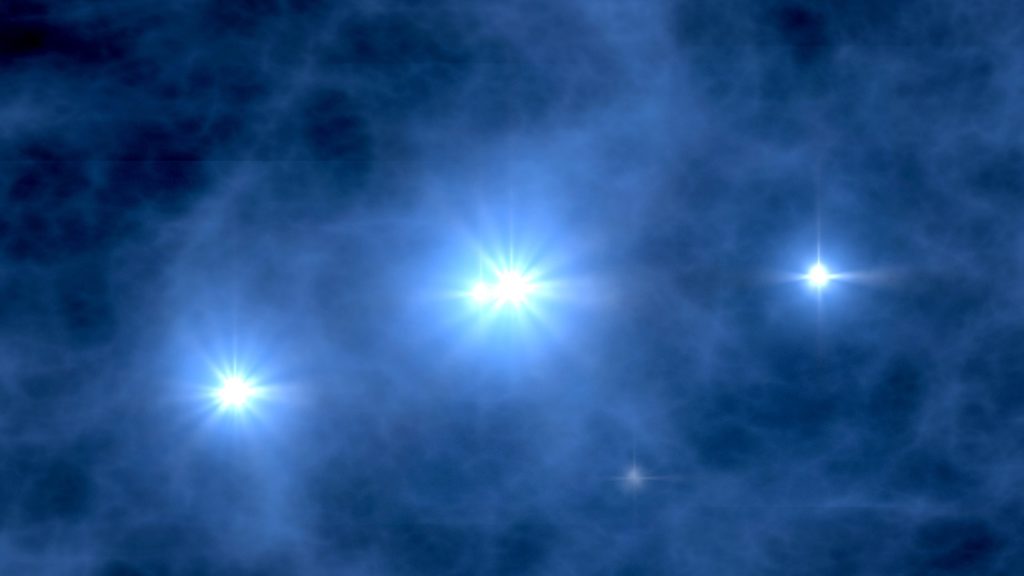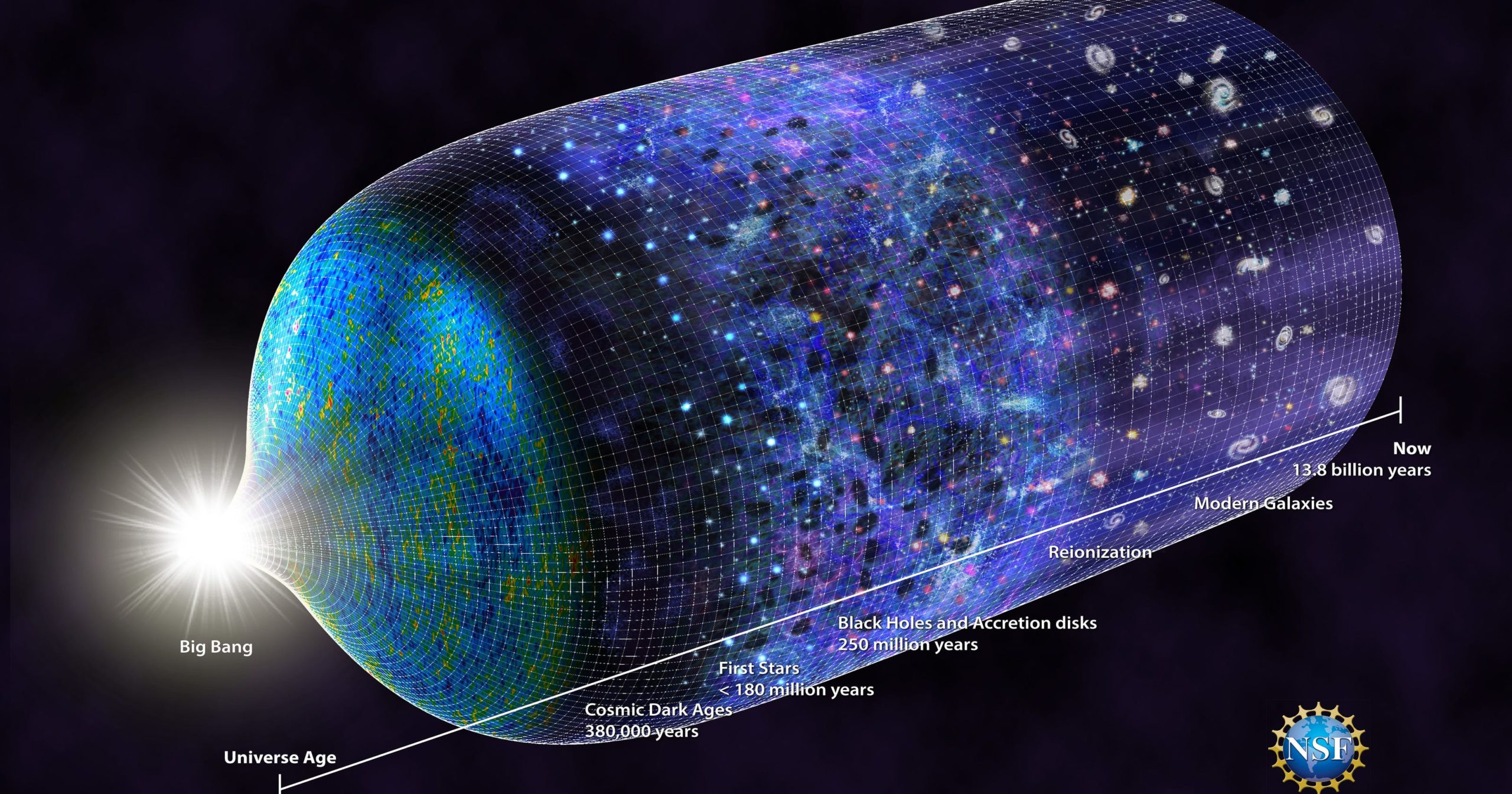Dating the Cosmic Dawn and Testing Creation
Beginnings tell us a lot about children. A child’s “firsts” inform us about his or her personality, development, and adult future. For these reasons parents are attentive to when their children first take an unassisted step, speak a recognizable word, count to ten, recognize letters in the alphabet, read a book, or swim in a pool.
Similarly, the universe’s beginnings tell us a lot about how it got to its present state. One of the most important beginnings in the universe is what astronomers call the cosmic dawn, that early epoch in the universe when it first became bathed in starlight (see figure). Asking exactly when the cosmic dawn occurred makes for a crucial and sensitive test of cosmic creation models and the reliability of the Bible.

Figure: Artist’s Concept of the First Stars Being Born in the Universe
Credit: NASA/WMAP Science Team
Previous Attempts to Date the Cosmic Dawn
Astronomers’ analysis of maps of the universe’s residual radiation from its beginning, called the cosmic microwave background radiation (CMBR), yielded the first measures of the cosmic dawn. Analysis of the large-scale polarization in the Planck satellite map of the CMBR indicated that the universe’s first stars were massive stars in newly formed low-mass galaxies. These stars were birthed at redshift z = 7.7 (a galactic distance measurement), which is 670 million years after the cosmic creation event (CCE).1
Measurements of the 21-centimeter spectral absorption line of neutral hydrogen reveal that ultraviolet photons produced by early star formation occurred before redshift z = 9.6 (before 500 million years after the CCE).2 The 21-centimeter neutral hydrogen line measurements made by the Experiment to Detect the Global EoR Signature (EDGES) showed that the intergalactic medium may have been heated by starlight as early as z = 15 (260 million years after the CCE).3
A spectroscopic measurement of the Lyman-alpha and O III emission lines in the galaxy MACS1149-JD1 established its redshift at z = 9.1096 ± 0.0006.4 Infrared photometry of MACS1149-JD1 yielded an estimated age of 290 million years for its dominant stellar component, which is consistent with a cosmic dawn at z = 15.4 ± 2.3 (about 250 million years after the CCE).
New Measurement of the Cosmic Dawn Date
A team of six astronomers led by Nicolas Laporte has endeavored to more accurately determine the cosmic dawn date by increasing the sample size of accurately measured galaxies beyond z = 9 from one to six.5 Laporte’s team used the European Very Large Telescope, the twin Keck Observatory telescopes, the Gemini South telescope and the Atacama Large Millimeter Array to more accurately measure distances to the six most distant galaxies currently known.
Laporte and his colleagues measured a redshift of z = 8.78 for the galaxy GN-z10-3 and z = 9.28 for the galaxy MACS0416-JD. For the galaxy GN-z9-1 they determined a likely lower redshift limit of z = 9. Together with the earlier measurement on MACS1149-JS1, Laporte’s team concluded that cosmic star formation must have been occurring before z = 10 (earlier than 480 million years after the CCE). Using the Hubble and Spitzer Space Telescopes, they made photometric measurements of the light emitted from GN-z10-3, GN-z9-1, and MACS0416-JD. These measurements showed that the stars in these galaxies were 150–250 million years old. Thus, Laporte’s team determined the most accurate measurement, so far, of the cosmic dawn date: 250–350 million years after the CCE.
Implications of the Cosmic Dawn Date
Laporte’s team was most excited about what their measurements mean for the James Webb Space Telescope (JWST) that is scheduled to be launched next month. Their observations demonstrated that the JWST will be capable of directly witnessing the cosmic dawn and determining a date about ten times more precise than the one achieved by their team. That is, we can soon look forward to an even more accurately defined cosmic creation model. Here’s why.
The cosmic dawn date determined by Laporte and his colleagues is consistent with the standard big bang creation model. This model posits dark energy as the primary component of the universe, dark matter as the second most abundant component, and baryonic matter (composed of protons, neutrons, and electrons) as making up virtually all the remaining cosmic stuff. The standard big bang creation model is consistent with the four fundamental features of the universe that the Bible uniquely taught for thousands of years before astronomers had any clue that the universe indeed possessed these features.6 Thanks to the telescope power presently available to astronomers—and soon to be greatly enhanced—the unique power of the Bible to correctly predict future scientific discoveries has been spectacularly affirmed. This demonstration gives yet more weight to the conclusion that the Bible is the inspired, inerrant revelation from the One who created the universe.
Featured image: Universe’s History Showing the Cosmic Dawn When Stars First Formed
Credit: National Science Foundation
Endnotes
- N. Aghanim et al., Planck Collaboration, “Planck 2018 Results. VI. Cosmological Parameters,” Astronomy & Astrophysics 641 (September 2020): id. A6, doi:10.1051/0004-6361/201833910.
- A. H. Patil et al., “Upper Limits on the 21 cm Epoch of Reionization Power Spectrum from One Night with LOFAR,” Astrophysical Journal 838, no. 1 (March 20, 2017): id. 65, doi:10.3847/1538-4357/aa63e7.
- Judd D. Bowman et al., “An Absorption Profile Centred at 78 Megahertz in the Sky-Averaged Spectrum,” Nature 555, no. 7694 (March 1, 2018): 67–70, doi:10.1038/nature25792.
- Takuya Hashimoto et al., “The Onset of Star Formation 250 Million Years after the Big Bang,” Nature 557, no. 7705 (May 17, 2018): 392–395, doi:10.1038/s41586-018-0117-z.
- N. Laporte et al., “Probing Cosmic Dawn: Ages and Star Formation Histories of Candidate z ≥ 9 Galaxies,” Monthly Notices of the Royal Astronomical Society 505, no. 3 (August 2021): 3336–3346, doi:10.1093/mnras/stab1239.
- Hugh Ross and John Rea, “Big Bang—The Bible Taught It First!” Facts for Faith (Quarter 3, 2000): 26–32; Hugh Ross, “Does the Bible Teach Big Bang Cosmology?” Today’s New Reason to Believe (blog), August 26, 2019.





